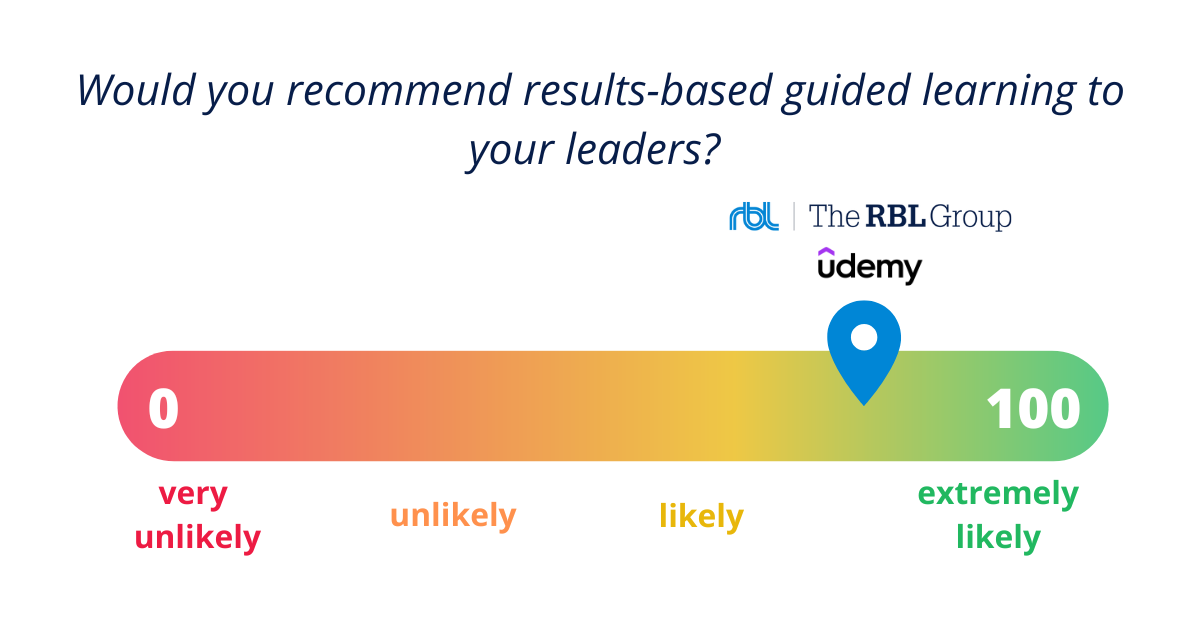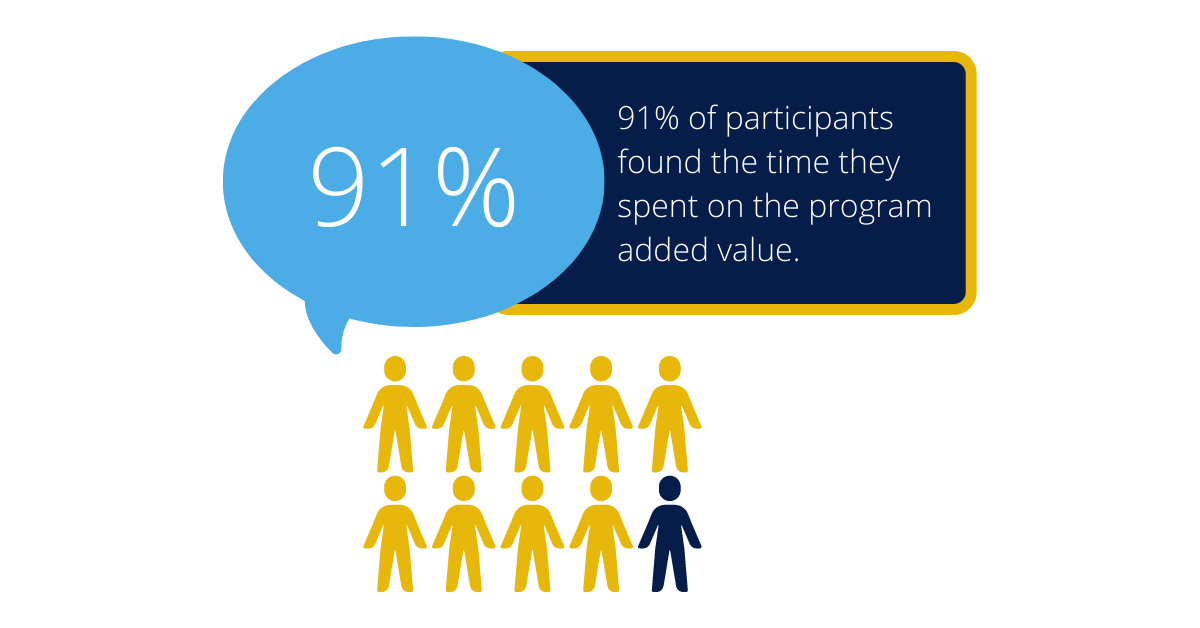Results-Based Guided Learning: A Highly Effective Learning Model
Key Take-Aways:
- Guided learning is a delivery approach that blends the best of independent and group learning through self-guided learning assignments (videos, reading, exercises) and a weekly facilitated insight and application session.
- Results-based guided learning builds a common language, perspective, and methodologies across individuals, teams, and leaders in areas such as starting from the outside in, stakeholder value, organization capabilities, and levels of contribution.
- Our joint experience and data show that participants in guided learning journeys are more likely to complete the courses and implement the lessons learned, as well as retain more information, see more value in the concepts, and feel more satisfied.

Results-Based Guided Learning: A Highly Effective Learning Model

Introduction
To successfully navigate today’s discontinuous world, organizations must build human capability and organization capability at speed and scale. When individuals work independently to develop skills, they don’t create the collective upskilling to impact overall human capability and therefore performance at an enterprise level.
Our guided learning journeys help build collective understanding and skills that leverage a common language and provide tools to build stronger human capability.
What is Results-Based Guided Learning?
Guided learning is a delivery approach that blends the best of independent and group learning through self-guided learning assignments (videos, reading, exercises) and a weekly facilitated insight and application session. It is a structured approach that combines asynchronous learning with synchronous learning. Our research indicates there are several differentiators between traditional and results-based guided learning models that directly impact overall completion, retention, and satisfaction rates 1.
In contrast, the traditional digital learning model typically involves video-based courses that people log in, stream, and complete on their own. There is limited peer-to-peer and instructor engagement, little to no accountability, and no discussion regarding company-specific action steps for applying the lessons learned.
Executive education programs built on the guided learning model outperform online models and produce results equivalent to our highly impactful face-to-face development programs, with the added benefits of scalability and cost-effectiveness. With results-based guided learning, participants:
- Complete more.
- Retain more.
- See more value.
- Are more satisfied.
- Are more likely to implement the lessons learned.
- Build common perspectives and language.
Complete More
Completion rates are more than 10.5 times higher for results-based guided learning programs than for general online courses. This is due to the learning model's design:
- Structure creates accountability. To be ready to engage in the live weekly facilitated session with a consultant and their peers, each participant must complete that week’s assignments in a timely manner.
- Asynchronous structure enables flexibility. Participants can work on bite-size micro-learning components on their own time.
- Diverse learning methods encourage engagement. Participants watch videos, conduct polls, complete worksheets, chat with cohorts and collaborate in live sessions.
- Collaboration and networking are motivating. Going through the program with a group of peers from your organization not only makes the process more enjoyable but also provides internal networking opportunities that participants may not otherwise have.
- The expectation of participation is set by management. Leadership receives progress reports that enable them to review progress and opportunities.
Retain More
Executive education programs are of little value if the participants do not retain any of the lessons presented. Retention is high for guided learning programs because:
- Facilitated sessions reinforce the learning. In addition to providing a review and addressing any questions, these sessions also include peer-to-peer engagement and dialogue plus a commitment to action steps. It’s a “learn and do” approach.
- Courses have high completion rates. Simply doing the work results in greater retention.
- Diverse learning methods reinforce retention. Participants will watch videos, conduct polls, complete worksheets, chat with cohorts, and collaborate in live sessions.
See More Value
At the individual level, the reasons why participants in results-based guided learning courses overwhelmingly believe that the material and courses are valuable can be attributed to a few factors:
- Relevant, research-based content from industry experts. Our entire approach to helping organizations with human capability across talent, leadership, and strategic HR is based on decades of research and a deep understanding of what is going on in today’s organizations. When people go through the programs it resonates with what they’re experiencing on a day-to-day basis.
- Impact of synchronous learning with a cohort group. There is built-in accountability, encouragement, group engagement, and group excitement, as well as support from the leadership team. As mentioned above, many see internal networking and relationship-building opportunities as valuable in and of themselves.
- Investment is tied to expectations. When organizations invest in results-based guided learning programs, they send a clear message to employees that building human capability and organization capability are top priorities. Participants see the courses as valuable because leadership has signaled that the programs are valuable to the organization as a whole.
Are More Satisfied
Our advocacy and satisfaction scores are in the top quartile. For this metric, we looked at a combination of Net Promotor Scores (NPS) and answers to survey questions regarding advocacy that are designed to go deeper than simple “satisfaction” to quantify the value that participants attach to their experience.
We believe that the same factors driving the things discussed above are driving this high level of satisfaction. With guided learning, participants are completing the course, retaining the information, seeing how these lessons apply to their work, and getting collective momentum with positive reinforcement from their teams.

Are More Likely to Implement the Lessons Learned
The data for guided learning shows an extremely high level of commitment to applying the learning. Once again, this goes back to the inherent design of this learning model. Organizations purchase these executive education programs and other courses because of their strong commitment to increasing human capability and organization capability. Participants find the lessons relevant to their work, have the advantage of going through the program with their peers and commit to specific action steps to apply the lessons toward organizational goals. Every step of the process is designed to reinforce the idea that this is actionable information, not just theoretical.
Build Common Perspectives and Language
Results-based guided learning builds a common language, perspective, and methodologies across individuals, teams, and leaders in areas such as starting from the outside in, stakeholder value, organization capabilities, and levels of contribution. When a team goes through a guided learning course together they come out with the ability to communicate with each other using the same language and construct, so they can solve a common problem from the same point of view.
Conclusion
As the data shows, results-based guided learning is a superior learning model by design. As compared to other options, participants complete more, retain more, see more value, are more satisfied and are more likely to implement the lessons learned.
One of the reasons why organizations get significant results from results-based guided learning programs is that these are not stand-alone classes taken by individual employees. They are team and organization-wide courses designed to build common frameworks for contribution.
We invite you to learn more about our results-based, guided learning journeys by visiting RBL Omnia, which shows a full suite of offerings to create greater business impact
1. The metrics presented in this article are based on our own experience with the RBL Group's Academies, as well as, data from Udemy's Corp/U.




